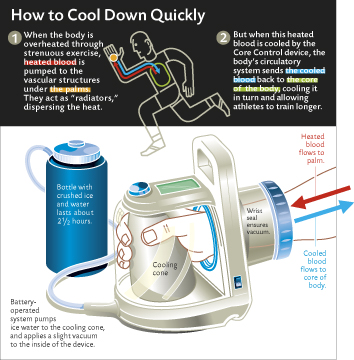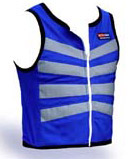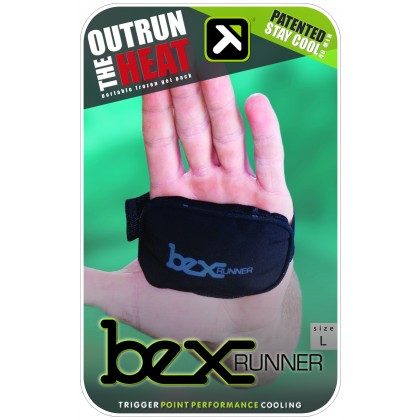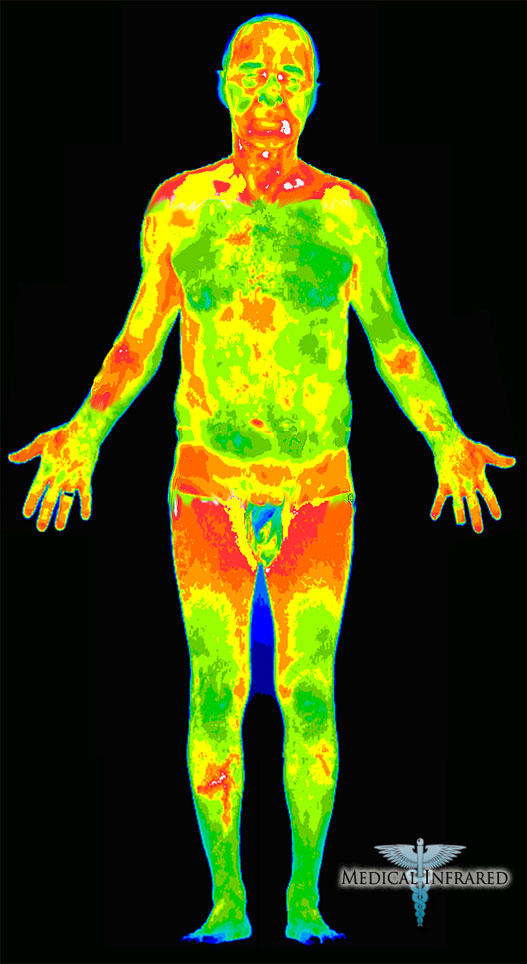Lower Core Temperature for 30% Performance Gain
There are currently some good solutions to lower core body temperature while you work out. This can have quite phenomenal performance benefits. The expensive option is CoreControl a special cooling glove developed by Stanford scientists.

http://www.stanfordalumni.org/news/magazine/2005/julaug/features/cool.html
http://www.avacore.com
These things cost $3000 so for me its not an option. What is an option is a vest, cap and bexrunner palm cooler. It may sound dumb that cooling your hand will affect core body temperature but it does. One athlete went from 200 to over six hundred pullups per workout in a six week period using the expensive cooling glove.



Your face, palms and soles of the feet are the main places that lose body heat. The palms have a strong neurological connection and also regulate body temperature. There are specialised thermo-regulation blood vessels at these body parts.
Heres an article on the CoreControl Glove
BY Eva Ciabattoni
http://www.stanfordalumni.org/news/magazine/2005/julaug/features/cool.html
Robert Weir, head coach of men’s track and field, gets ready for his strength-training regime by loading hundreds of pounds of weights onto both ends of a bar that rests in brackets at shoulder height. Weir moves under the bar, hoists it across his shoulders and does squats. With each repetition, his knees and hips fold until his thighs are parallel to the ground, then straighten—rep after rep with the equivalent of a baby elephant draped around his shoulders.

Like any athlete, Weir is well acquainted with his normal performance range. Like any athlete, Weir looks for an edge. A few years ago, he was intrigued when he heard about a device—that has been called at various times the RTX, Core Control or simply The Glove—invented by a pair of Stanford biologists. Using the device to lower his core body temperature between sets, he was able to lift 495 pounds in four sets of squats instead of his normal two. He usually does squats only on Mondays, but he decided to try a second series a few days later. That Friday, he was able to increase the weight to 545 pounds. “I was surprised the sets felt so good,” he says, but adds that the real test came the following Monday. Weir, 44, expected to see significant performance degradation due to the extra Friday workout. Not only did he not see the decay, he increased weight with every set. The RTX—for rapid thermal exchange—cooling device “is a very serious piece of equipment,” he says. “At my age, you don’t expect to be setting personal bests during workouts.” He trained with the cooling equipment for the 2002 Commonwealth Games, and placed third in the discus. His oldest competitor was 15 years younger.

RTX promises to enhance human performance in applications ranging from sports to medicine to the military. It is the brainchild of biological sciences professor H. Craig Heller and senior research scientist Dennis Grahn, who have spent nearly two decades studying temperature regulation in mammals. Their lab, once devoted to hibernating ground squirrels and marmots, now attracts San Francisco 49er football players, military representatives from the Defense Advanced Research Projects Agency, multiple sclerosis patients and sweating Stanford athletes.
COLD SHOULDER: Grahn and Heller got a chilly reception from some scientists when they first published their findings in 1998.
The fourth floor of Gilbert Biological Sciences Building holds many iterations of Heller and Grahn’s inventions to heat and cool humans. One of the earliest contraptions circulated warm water around an arm encased in a clothes-dryer duct and sealed with neoprene. It was designed to warm patients recovering from anesthesia.

The drugs that render patients unconscious also make them hypothermic. That’s useful because chilled patients bleed less during surgery; but as they start to wake their violent shivering can tear fresh sutures, damage teeth and put extra stress on heart and lungs. It’s important to warm patients quickly after a procedure, and traditionally that’s been done with hot air or blankets. The trouble, Heller explains, is that because the body’s core is still cold, blood flow is pulled away from the skin to preserve internal body heat. Warm blankets heat the skin, but without a ready supply of blood circulating near the skin surface, this warmth is not transferred efficiently to the body’s interior.
Heller and Grahn found that heating only an arm with their device served to warm patients more rapidly than would have been expected via normal heat transfer through the percentage of skin surface being heated. After modifying their design, they realized that they could achieve the same rate of rewarming by encasing just the hand.

Mammals have specialized blood vessels in their palms and other hairless skin surfaces—ears, nose, cheeks and soles of the feet—that are designed to dissipate heat. (These radiator-like structures—venous plexuses and arteriovenous anastomoses—were described as early as 1858 in Gray’s Anatomy.) By redirecting blood away from the capillaries and into these blood vessels, the body can shed heat quickly. What Heller and Grahn were seeing was the return trip: when externally applied heat shocked open the radiators in the cold palms of anesthesia patients, warmed blood was returned straight to the heart, and the body was reheated from the inside out. Applying a mild vacuum to the hand intensified this effect.
Their finding that heat loss is not uniform across the body was slow to gain acceptance. In the Journal of Applied Physiology, where their research was first published in 1998, Heller and Grahn issued a frosty rejoinder to skeptics: “since we present not just a claim but hard data, it is nice to emphasize that when data do not fit a model it is time to reexamine the model.”
Nigel Holmes
After hearing of their rewarming research, a postdoctoral student in molecular biology and neuroscience approached them to see if the same radiator mechanism could be used to cool the body core. Louise Bitting, PhD ’94, had read that the cooling of cells containing the cystic fibrosis mutation had halted the disease process in those cells. She wanted to study if cooling might work outside a Petri dish. (Bitting died unexpectedly in 1999 at the age of 49.)
A lab technician who was also a body builder, Vinh Cao, volunteered to be the test subject. To generate metabolic body heat, Heller and Grahn had him do sets of pull-ups to exhaustion. He started with a set of 14 pull-ups and soon dropped to eight per set. After 20 minutes, they applied cooling and a vacuum to Cao’s hand. When they asked him to do more pull-ups, they were amazed to see his performance jump back up to 14 pull-ups. To make sure the improvement wasn’t caused by the rest period, they did a study without cooling. Cao did 10 pull-ups.
They continued to study Cao for the next six weeks. If they applied cooling between sets, Cao’s performance held steady in set after set. Without cooling, it decayed. “It was as if he had no fatigue,” Heller recalls. “We saw incredible gains over the next six weeks. He tripled his capacity to 620 pull-ups.” Preventing muscle exhaustion allowed Cao to train harder, leading to rapid gains in muscle strength. Heller and Grahn theorize that more blood, and thus, oxygen, is available to the muscles when the body doesn’t have to route extra blood to the radiators for cooling.
Excited by what they had learned, they arranged a presentation in 2000 to Stanford athletics coaches. Heller remembers the stony faces and crossed arms that greeted them. “It was not a warm welcome. The four or five coaches who showed up didn’t seem to think that a couple of biologists could tell them anything about performance enhancement.” Only Weir agreed to try it. Off campus, the 49ers and Raiders football teams were the earliest adopters—later followed by the University of Miami football team, the NBA’s Milwaukee Bucks and the Manchester United soccer team.
When a battery-operated model of the RTX became available, the Stanford football team started to use it. Head athletic trainer Charlie Miller made an inadvertent breakthrough when one his players came off the field with leg cramps during the third quarter of a game against Boston College early in the ’02-’03 season. “Since cramps tend to recur, a coach has to decide between benching a key player or keeping him on the field and risk another cramp recurring in the middle of play,” Miller explains. In addition to conventional treatments—massage, electrolytes, fluids—Miller had him put his hand into the RTX. To his surprise, the cramp disappeared and the player was able to finish the game. “When the IV fluids worked [to revitalize a player], it wasn’t the minerals or the rehydrating,” he says, “it was because we were invasively cooling the players down. We had noticed that if the IVs were kept on ice, they worked better. Now we know why.”
Miller says the RTX is a competitive advantage because it allows a coach to keep his best players on the field. Because the device is so new, there are no requirements yet for the host team to provide one to the visiting team, as there are for other amenities.
Ever seeking a competitive edge, athletes began paying regular visits to the fourth floor of Gilbert, causing one of the staff to remark that the hallways had gotten smaller. A former NFL player told Grahn, “This replaces the Juice,” referring to steroids. Weirdly, cooling does mimic steroids in the way it allows an athlete to recover from intense exertion quickly, allowing someone to do more work in a shorter period of time. But cooling doesn’t result in shriveled gonads or ’roid rage.
Cooling mimics steroids in the way it allows an athlete to recover from intense exertion quickly. But cooling doesn’t result in shriveled gonads or ’roid rage.
Critics might worry that cooling masks the body’s signals to stop. In fact, lab data show that athletes who train with cooling perform better in all kinds of conditions—even competitions when cooling is un-available. Heller says removing heat from the body is no different from giving it a drink of water in response to thirst. Asked whether training with cooling might lead to overuse injuries, Weir shakes his head. “It doesn’t allow you to do work you couldn’t ordinarily do. It allows you to recover faster.”
Meanwhile, researchers continue to investigate therapeutic uses for cooling. One exciting area of research involves multiple sclerosis, a disease where even a 1/2-degree Celsius rise in core body temperature can lead to rapid and dramatic physical and cognitive decline. (MS sufferers say the sudden enervation feels as though a switch was flipped.) The disease destroys portions of the fatty myelin sheath that insulates nerves; heat disrupts the electric impulses traveling along the frayed nerves. Retaining strength—key to staying out of a wheelchair—is a significant challenge for MS patients, for whom fatigue can lead to a spiral of debility.
Jim Seaton, a management consultant who lives in Washington, D.C., has MS. Once a top runner and avid hiker, he has to be cautious about exertion. He pushed himself too far once and had to crawl back to his car in the parking lot; recovery to his baseline level of functioning took two days. Seaton, after hearing a radio report about cooling athletes, arranged to try the RTX to see if it reduced the fatigue that resulted when his body warmed up. Using the RTX, he can cool to his resting state in 10 to 15 minutes—and then continue to hike. The RTX isn’t exactly convenient: the $4,000 unit weighs 12 pounds and has to be reloaded with ice every 2 1/2 hours. But owning one changed his life. “I’m already planning trips to the museum [and] to Europe that I would have thought thrice about before.”
At their boneyard of core-cooling machines in the Gilbert building, Heller and Grahn describe the difficulty in perfecting the design for a functional, portable RTX. There’s the coffeepot-shaped version. The $400,000 version by a name-brand design firm that really never worked. The version constructed in a size-10 boot that, once loaded with tubes and a cooling surface, wouldn’t fit on even a size-5 foot. Grahn’s latest homemade version features soft vinyl against the hand instead of metal. One design challenge is obvious—how to create a vacuum-bearing glove flexible enough so that its wearers can use their hands, not just sit cooling their palms.
Variable temperature control is another desirable feature. When a hot body core issues a command to open the radiators and dump heat, the palm can override that command and order the radiators to shut down based on local conditions, i.e., if the palm touches a cold surface. This was borne out in February when Grahn flew to Alaska to observe dog teams competing in the Iditarod. Temperatures rose to 46 degrees in Anchorage—downright tropical for the huskies. Grahn watched sled dogs through an infrared camera—and saw snouts and ears lit up like headlamps, indicating that the dogs were shedding excess body heat. But the cameras showed no heat loss through the dogs’ feet. Snow under their paws prevented those radiators from opening. Heller and Grahn have found in the lab that the temperature under which the radiators shut down in humans is highly individual.
Heller and Grahn have received a series of patents through Stanford’s Office of Technology Licensing, which will share in any royalties. They are founders and major stakeholders in AVAcore Technologies, a Michigan firm charged with making the RTX commercially viable. (The company moved from the Bay Area to Ann Arbor in 2003 to take advantage of engineers laid off from the automotive industry.) “It’s hard to build a compressor small enough to be useful in portable situations,” says Ronald Piasecki, chief executive officer of AVAcore. “Eventually nanotech may play a role in accomplishing our engineering goals.”
Piasecki has overseen improvements to the RTX manufacturing process, reducing the cost and time to build each Core Control machine. “Clearly, the athletic market is the low-hanging fruit,” he says of the 100 units sold so far. “But this fall we’re starting a study of MS patients in conjunction with the University of Michigan neurology department.”
Heller remains confident that the technology can be brought to wide markets. “There are many applications of both heating and cooling,” he says. “Firefighters, soldiers in full gear in the Iraq desert, stroke victims [where cooling patients can prevent further damage], cancer patients [where heating can increase effectiveness of chemotherapy drugs], cystic fibrosis, heatstroke victims”—all are potential beneficiaries of RTX.